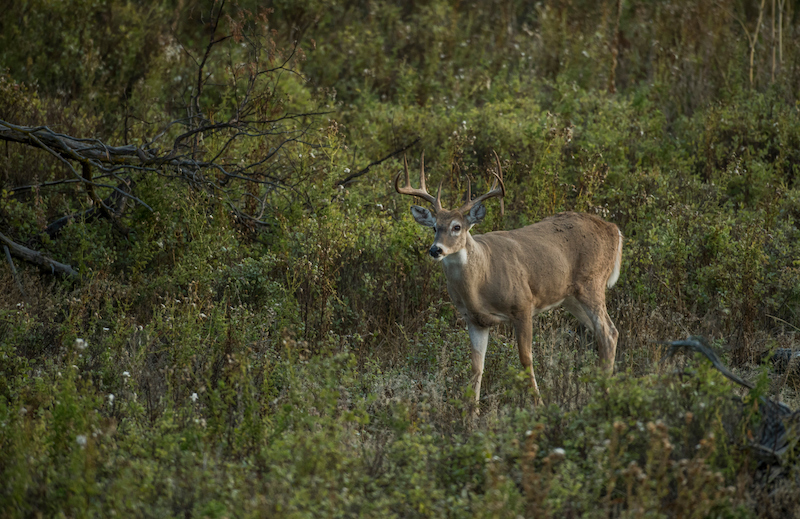Identifying ideal deer habitat is nearly impossible, given that whitetails roam from South America to the Yukon Territory, and nearly sea to shining sea.
One reason whitetails are so widespread is because they’re adaptable. They can digest dozens of plant species, and they’re at home in suburbs, wilderness areas and nearly everywhere in between.
But no matter where whitetails live, they need reliable food sources and protective bedding cover. After all, deer spend most of their time eating, resting and digesting what they ate. Also remember that deer are edge creatures. They use heavy cover for bedding, and make feeding forays into more open areas with better plant growth.
Corners along field edges are classic whitetail hangouts. The “field” could be fallow, or it could be a small food plot or a sprawling agricultural cash-crop. The exact crop doesn’t matter. It just needs to attract deer.

Deer use thick trees for cover, so look for wooded areas near a clearing or food plot. Photo credit: John Hafner
Deer usually bed in nearby cover, whether it’s trees, brush or even tall grasses. They’re seldom far off the field’s edge unless they’re often bothered by predators or two-legged hunters. Deer generally await low-light periods before venturing into the open to feed, but they’ll often get antsy beforehand and mill about near the edge. Ground blinds and treestands just inside this cover can be deadly, especially for nocturnal bruisers that refuse to step into the open during shooting hours.
Most bowhunters know those basic examples, but some bowhunters are surprised how much time deer spend in more open areas. A classic bedding site is a lone conifer or scattered evergreens on a hillside. Deer love bedding in such spots, even if the site offers little other cover. They bed under the tree’s secure branches to watch for downwind danger, and use their nose to scan for predators upwind. Likewise, bowhunters can use binoculars or a spotting scope to find bucks in such habitat, but moving into bow range is challenging.
Deer attractants vary through the seasons. When food is plentiful, deer can be choosy and target the most succulent forbs. But in winter or during droughts, deer must often be less choosy, and sometimes eat low-nutrition foods. Either way, their hangouts change. An oak ridge might have little appeal in spring, but become a magnet in fall if there’s a bumper acorn crop. The same goes for agricultural crops and food plots. When a food source is at peak nutrition for deer, you can bet it’ll soon attract whitetails.

Water sources are also popular with whitetails because they can get both food and water in the same place. Photo Credit: John Hafner
Stream corridors are great places to find whitetails. Riparian soils tend to be moist and more fertile than the surrounding landscape. This aids the growth of vegetation and brushy cover. In addition, in the Midwest’s agricultural areas or the West’s open grasslands, streamside vegetation might provide the only cover around. Thus, stream bottoms can serve as feeding areas, bedding sites and travel corridors year-round.
Brushy thickets are also great whitetail haunts. Brush species vary by location, but red osier dogwood is common across much of the whitetail’s range. This close-growing species forms great protective deer cover, and doubles as a food source much of the year.
Natural mineral licks aren’t common in most areas, but if you find one, be assured deer will visit at some point.
It’s easy to take water sources for granted when and where moisture is plentiful. But if you find a reliable source where water is typically scarce or inconvenient to reach, deer will concentrate nearby and visit regularly, especially in hot, dry conditions.
Manmade cover sometimes benefits deer, too. In recent years, more landowners are taking time to create bedding/feeding areas by hinge-cutting trees and creating large openings in woodlots to spur vegetation growth. To hinge-cut trees, a skilled chainsaw operator fells a tree about 4 to 5 feet above the ground, but doesn’t cut all the way through. That lets it fall in a hinge-like fashion. Ideally, the tree stays alive for another season or longer, and sprouts new growth within easy reach of browsing deer.
The toppled tree also provides cover and, given the high stump, deer can walk beneath it to create a well-protected travel corridor. By doing such work on a relatively large scale, habitat managers create thick bedding areas with plenty of accessible browse. Bowhunters, of course, usually fell these trees to create pinch points for ambushing their prey.
Identifying deer hotspots across diverse whitetail country isn’t easy. But if you lace up your boots and get into the woods, you’ll find the sites that whitetails consider most ideal.